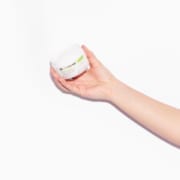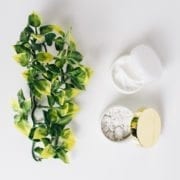The Best Thing You Can Do for Your Skin
Ever wonder why a baby’s skin is so soft? It’s because babies naturally replace their skin cells every few days. As you grow older, however, the rate of skin cell turnover slows down dramatically. Dead cells on your skin’s surface hang around much longer, a fact that tends to accentuate those fine lines and make your complexion look dull and lifeless. By removing these dead skin cells, exfoliation helps make up for the gradual slowing down of your natural skin renewal process, improving the tone and texture of your skin.
The process of exfoliation is a lot like peeling away the dry, outer skin of an onion to reveal the living layers beneath. Whether the exfoliation is done using mechanical abrasion or a controlled chemical reaction, removing dead and damaged skin cells on the surface allows the fresh new skin underneath to become visible. This newly exposed layer of skin feels much softer and smoother. Its surface reflects light better, making fine lines and other small imperfections harder to see. Age spots and other areas of unwanted pigmentation are less noticeable because the dead skin cells containing the pigment have been removed. Exfoliation unplugs clogged pores and allows for the release of natural skin oils. Regular exfoliation also helps to maintain open pores, decreases pore size, and minimizes many types of superficial scarring. In addition, removing the top layer of dead and damaged cells allows other health-promoting agents such as moisturizers, antioxidants, and collagen-boosting ingredients to better penetrate the skin and work more effectively.
Discover the differences in Physical vs. Chemical exfoliating agents:
Alpha Hydroxy Acid or AHA (which are Lactic acid, Glycolic acid and the Fruit acids) is used as a facial exfoliator and is an excellent choice for people with sun damaged skin, aging skin and normal to dry skin types. AHA does not cause sun sensitivity and comes in many forms. AHA’s come in the form of lactic acid which is derived from milk, glycolic acid which is derived from sugarcane and fruit acids which are derived from fruits (citrus and apples/malic acid). AHA can also aid in thickening the lower layers of the skin thus delivering firmness.
Beta Hydroxy Acid or BHA (also called salicylic acid) comes from acetylsalicylic acid which is the same source as aspirin. In general, beta hydroxy acid is a more effective treatment for acne prone skin. BHA also can cause sun sensitivity and must always be used in conjunction with a sunscreen.
– AHAs are water soluble and are preferred for normal to dry, sun-damaged skin due to their ability to enhance natural moisturizing factors within skin.
– BHA is oil soluble and preferred for normal to oily, clog-prone and bump-prone skin, and enlarged pores, and can clear pores deeply, even those with hard, tiny, white bumps on the cheeks and face. BHA is even suitable for those prone to milia.
– AHAs and BHA work on skin’s surface; but BHA also works inside the pore lining, where clogs begin.
– BHA has natural skin-calming properties, which make it preferred for sensitive, redness-prone skin. It’s great for sensitive skin, even for those with rosacea.”
In general, choosing the right exfoliating scrub from all the commercial products on the market today depends a great deal upon the thickness and sensitivity of your skin. It’s important to remember that all kinds of particles can be used for exfoliation, and mainstream products encompass a wide and varied selection. People with oilier complexions have larger sebaceous glands which makes their skin thicker and better able to tolerate larger, more abrasive particles such as pumice or magnesium oxide crystals. Those with drier, sensitive skin should generally use products with smaller granules such as jojoba beads or ground oatmeal.
It’s important to realize that certain ingredients, although natural, may not be appropriate for your skin type. Some natural products, such as crushed nutshells, sea shells, pumice, ground fruit pits and seeds, have uneven edges and irregular shapes that can damage sensitive skin.
The best exfoliating scrub is the one that effectively removes your stratum corneum but, at the same time, is gentle to the rest of your skin. Over the course of many years in private practice, I’ve conducted dozens of clinical studies in an effort to discover the perfect combination of particle type, size and density that would consistently yield the best overall results for patients with different skin types. After numerous experiments I finally found an exfoliate that I consider ideal for personal use which offers similar results to machine-administered microdermabrasion without incurring the time and expense of going to a dermatologist. However, in order to achieve my objective of creating an exfoliating cleanser that was gentle enough to be used daily, I had to incorporate a very unique type of crystal particle in the formula. I chose Ruby Crystals – they are perfectly round in shape and finite in size to allow for all surface dead skin cells to be polished without causing any tearing or abrasion to the skin.
Dr. G’s Tips:
DON’T OVER EXFOLIATE- This is perhaps the most important thing to remember so that you can avoid any damage and/or irritation of the skin. It’s safe to assume that exfoliating twice weekly can achieve great results and refrain from irritation or over exfoliating. Of course, there are the people who enjoy exfoliating daily, but this is personal preference and heavily based on your skin type. If you notice a burning sensation or it your skin becomes very sensitive and/or red after using a product, stop it. Ultimately, you should stay in tune to what your skin needs, feels and looks.
DO EXFOLIATE ALL OVER- Exfoliation does not store at your face. Work your exfoliation routine down into the neck and décolleté area, even your lips too as these areas can greatly benefit from exfoliation too as it removes dead surface skin cells, brightens overall skin tone and improves texture. Other areas to exfoliate: your elbows and knees.
DON’T GO SUNBATHING AFTER EXFOLIATING- Exfoliating reveals a baby-fresh layer of skin, you could be more susceptible to the
sun’s rays. Use caution when heading outdoors. Use a higher SPF in your sunscreen, wear a hat, carry a sun umbrella and try to stick to shady spots whenever you can.
DO EXFOLIATE AT NIGHT- Skin renews itself overnight so the perfect time to exfoliate is right before bed. Use a good sunscreen with high SPF during the day, especially if your skin has recently been exfoliated. While we all want smooth and clear skin, it’s we also want to protect against sun damage.
DO CONSIDER CHEMICAL EXFOLIANTS- Physical exfoliants aren’t the only want to slough off dead skin to reveal a brighter complexion. Ingredients that chemically exfoliate the skin include glycolic acid, alpha-hydroxy acids, lactic acid and various enzymes.










Leave a Reply
Want to join the discussion?Feel free to contribute!